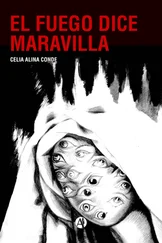The years went by in a never-changing routine. Every morning she would sing with the children. In the afternoon she visited the sick and the bedridden, describing to the dying the wonders that awaited them. Then back home she would recite prayers or sing hymns with the women. She only stopped at nightfall, when she would begin to talk of God and the afterlife. No visions of the apocalypse or torrents of imprecations, but sweet-sounding words that compensated for our daily lot of suffering on this earth. Men and women alike never tired of listening to her depict the Garden of Eden planted with the tree of life in the very middle, the tree of the knowledge of good and evil, surrounded by a tangle of oleander and all sorts of sweet-smelling flowers. Every Maundy Thursday in the afternoon her torture began. On Good Friday, as she lay on her cot, the stigmata dug into her hands and feet, the wound pierced her left side, and the the crown of thorns lacerated her forehead with blood. She sweated, doubled up in pain, and sobbed all day Easter Saturday racked by unspeakable suffering. Then on Easter Sunday she would rise up like our Lord Jesus Christ and, haggard and drawn from the pain, go and kneel outside to start singing the Veni Creator .
This happened Holy Week after Holy Week. After several years the prodigy came to the ears of folk from the neighboring villages of Saint-Esprit, Maraudeur, and Vieux-Habitants. They would begin flocking to Ravine-Vilaine on Palm Sunday, sleeping under the trees in the surrounding woods. On Easter Sunday they would file back home in a procession chanting hymns to the glory of God. One year, Sister Tonine began to perform miracles. It started with Madame Eudoxie, the doctor’s wife from Saint-Esprit, whose novenas and husband’s know-how had never been able to produce a child during their twelve years of marriage. On Easter Saturday Madame Eudoxie wiped the sweat from Sister Tonine’s brow, begging her to inter-cede with the Almighty on her behalf, and one month later she missed her period. Nine months later she gave birth to a baby boy. The miracles continued with Madame Patient, the tax collector’s wife from Cantilène, who gave birth to twins on the eve of her menopause. Soon there was a crush of well-to-do women who came looking for a cure for infertility, since this class of women is more susceptible to this kind of affliction.
Sister Tonine had but one enemy, the priest at Saint-Esprit who came up to say mass at Ravine-Vilaine on Sundays at eleven. In his words, a creature who claims to imitate the Son of God and openly flaunt His stigmata is guilty of the sin of pride. Sister Tonine was a dangerous crackpot. Suspicious, he launched an investigation and came up with quite a few revelations. According to him, Sister Tonine was born at the other end of the island in the region of Port-Louis, which swarmed with mixed-bloods of every color as a result of the encounter of the three races of Europe, Africa, and Asia in the cane fields. While she was still a suckling, her parents had left her on the steps of the church, together with her brothers and sisters, and hung a sign around her neck with her name on it. Apparently the parents must have been Chinese or Indian, with a good deal of black blood, given the color of their offspring. Since the name wasn’t Christian, the priest at Port-Louis baptized her before taking her to the orphanage. Tonine excelled by her good behavior, learning her catechism by heart and abiding by God’s commandments. She served as an apprentice, then left for La Pointe. Then things took a turn for the worse. She met a shady character, a good-for-nothing, and from then on spent most of her time visiting him in jail. She followed him to Basse-Terre, where he must have been mixed up in some dirty business, and there it seems she had a baby girl who died at birth. She must have already been mentally deranged at this point, for she had trouble getting over the incident, which was certainly painful but nothing unusual in a place where hygiene left much to be desired and there was no neonatal medicine. She remained convinced that the child was alive, adopted by a well-to-do family, and insisted on getting her back. In fact, she saw the child everywhere. The priest managed to interrogate Dr. Médéric who on several occasions had treated her in his paupers’ ward at the Sainte-Hyacinthe hospital. Breaking the Hippocratic oath, the doctor told him he believed Tonine was suffering from Kirschenfeld’s disease, an ailment with symptoms of obsessions, hallucinations, fainting fits, and rashes. Armed with this information, the priest of Saint-Esprit didn’t require much more to gaily conclude that Sister Tonine was mad! He sent a report to the bishop, asking him to intervene. In a diocese like Guadeloupe there are so many problems to handle that the letter remained unanswered. So he took justice into his own hands and thundered against the poor woman from his pulpit. He showered her with contempt, heaping on insult to injury to such an extent that the villagers of Ravine-Vilaine revolted. They in turn wrote to the bishop and didn’t desist until Bishop Chabot dispatched the undesirable individual to France to purge his venom.
It was during the month of May that Sister Tonine fell ill. That year the rainy season had been so wet that the region, accustomed, however, to soaking up water, was transformed into a quagmire. The villagers were up to their knees in mud. If you didn’t watch out, you risked being sucked under. Frogs, toads, and snakes emerged from every hole and wallowed in the thick sludge. Sister Tonine disregarded Father Albertini’s advice. Come rain or shine she continued to carry the word of God to those who needed it. Not surprisingly, she caught a chill. She had never been very sturdy. All at once she seemed to shrink, shrivel, grow stooped, and become as gossamery as an angel. Her complexion was blemished by ashen streaks. A dry, persistent cough tore at her chest. Sometimes she spat blood. But she refused to take infusions or apply lotions and poultices and repeated to those who begged her to take care of herself that if the Good Lord had decided her time had come, she should not have the audacity to disobey Him. Soon she could no longer feed herself. In a panic the women sent one of their boys to fetch the doctor in Saint-Esprit. Alas, he was slowed down by the spongy terrain, the buttress roots, the weeds, and the undergrowth that had sprung up from the rain. He had barely reached the pass of La Mulatière when Sister Tonine passed away.
At that time there were no cards announcing the funeral. Yet the news spread by word of mouth like wildfire. People came from every town, from every village, from every hamlet and every locality, weeping as if they had lost their mama. Before leaving those who had loved her so dearly, Sister Tonine sprinkled a few last miracles. She thus made a present of a son to Mama Célariée, who hadn’t seen her blood for ten years and hadn’t been with a man either during the same period of time. People were surprised at first, almost in shock. Then they recalled the affair of the Virgin Mary and said among themselves that the Holy Ghost blows wherever he likes.
When the women fell silent, Celanire, her face in tears, turned to ask Elissa:
“What do you think of all that?”
Elissa shrugged her shoulders. Not much; she didn’t think much of the same old story she had heard a hundred times before. In Guadeloupe you could find a dozen stories, each one more surprising than the next, where ignorance, religion, and magic bickered with each other. At Vieux-Habitants a girl who had given birth to a baby boy on December 25 demanded he be called Jesus. At Calvaire, another preached with the voice of Our Lord Jesus Christ and was supposed to work miracles. She was said to have restored sight to a blind man and speech to a mute. A load of nonsense!
Читать дальше












